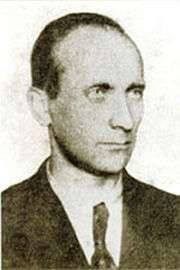Dmytro Klyachkivsky
| Dmytro Klyachkivsky | |
|---|---|
|
Dmytro Klyachkivsky | |
| Born |
4 November 1911 Zbarazh, Galicia, Austria-Hungary |
| Died |
12 February 1945 (aged 33) Orzhiv near Rivne |
| Cause of death | Killed in action |
| Nationality | Ukrainian |
| Other names | Klym Savur, Okhrim, Bilash |
| Organization | Ukrainian Insurgent Army |
| Political party | Organization of Ukrainian Nationalists |
Dmytro Klyachkivsky (Ukrainian: Клячківський Дмитро (Роман); 4 November 1911 - 12 February 1945), also known by his pseudonyms Klym Savur, Okhrim, Bilash, was a commander of the Ukrainian Insurgent Army (UPA), first head-commander of the UPA-North. He was responsible for the ethnic cleansing of Poles from Volhynia.[1][2][3]
Biography
Klyachkivsky was born on 4 November 1911 in the city of Zbarazh, Galicia, Austria-Hungary (now Ukraine) as a son of a bank clerk. He completed his secondary studies and entered the Law faculty of the Jan Kazimierz University in Lwow. A member of the Organization of Ukrainian Nationalists (OUN), he served in the Polish army and worked in the service sector in Stanisławów from 1934 until 1939 as chair of a committee of the Ukrainian sport organization Sokil in Zbarazh.
After joint Nazi and Soviet attack on Poland, Eastern Poland was occupied by the Soviet Union (see Territories of Poland annexed by the Soviet Union). Klyachkivsky was arrested by the Soviets (NKVD) in Lviv, and sentenced to death which was commuted to 10 years incarceration. He escaped from the Berdychiv Prison in July 1941.
He was a member of the Directorate of the OUN in Lviv, the regional leader of OUN from January 1942, a member of the leadership of OUN and the first commander of the Ukrainian Insurgent Army from 1943. He was given the rank of Major and made the regional commander of UIA-North in 1944.
Massacres of Poles in Volhynia
Dmytro Klyachkivsky is regarded as the initiator of the massacres of Poles in Volhynia in modern-day western Ukraine in the years 1943-1945. It was his directive, issued in mid-1943, that ordered the extermination of the Polish population across the province.[1] One Ukrainian Insurgent Army commander who opposed it was threatened by Klyachkivsky with court-martial.[2]
Evidence of his actions was found in SBU archives by Polish historian Władysław Filar and was published in 2000 in his book "Before action Wisla, there was Volhynia". It was an order addressed to the commanders of the Ukrainian Insurgent Army in Volhynia. This secret directive stated:
We should undertake the great action of the liquidation of the Polish element. As the German armies withdraw, we should take advantage of this convenient moment for liquidating the entire male population in the age from 16 up to 60 years. We cannot lose this fight, and it is necessary at all costs to weaken Polish forces. Villages and settlements situated next to the large forests should disappear from the face of the earth.[3][4]

Nevertheless, as noted by Timothy Snyder, among the tens of thousands of Poles murdered by UPA on his orders, most of the victims were women and children.[5]
Death
Klyachkivsky died in battle against the forces of the NKVD in January 1945 near the settlement of Orzhiv in the vicinity of Rivne. He was posthumously awarded the title of Colonel of the UIA and UIA Gold Cross of Military Honors First Grade.
See also
- Roman Shukhevych, general of the Ukrainian Insurgent Army
References
- 1 2 Matthew J. Gibney, Randall Hansen, Immigration and Asylum. Page 205. Google Books
- 1 2 Tadeusz Piotrowski, Genocide and Rescue in Wołyń. Page 187. Google Books
- 1 2 Władysław Filar, Anti-Polish actions of Ukrainian Nationalists (in Polish)
- ↑ Tadeusz Piotrowski, Genocide and rescue in Wolyn, p. 180. Google Books
- ↑ Timothy Snyder. "A Fascist Hero in Democratic Kiev". The New York Review of Books. NYR Daily.
Bandera aimed to make of Ukraine a one-party fascist dictatorship without national minorities... UPA partisans murdered tens of thousands of Poles, most of them women and children. Some Jews who had taken shelter with Polish families were also killed.
External links
| Wikimedia Commons has media related to Dmytro Klyachkivsky. |
- (Ukrainian) How many soldiers were in Ukrainian Insurgent Army? Ukrainian Pravda (3 December 2010)
